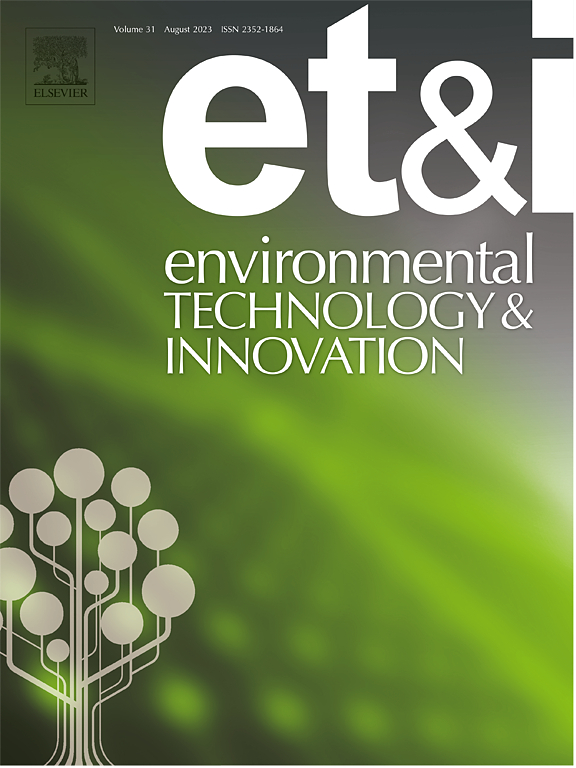Soil ecosystem multifunctionality and growth characteristics of Leymus chinensis were enhanced after sandy soil amendment with vermicompost and soil conditioner in soil-plant-microbe system
IF 6.7
2区 环境科学与生态学
Q1 BIOTECHNOLOGY & APPLIED MICROBIOLOGY
引用次数: 0
Abstract
The vermicompost coupled with coal-based soil conditioner has the potential to improve soil physicochemical properties and enhance the growth of plants. It plays a crucial role in facilitating the biogeochemical cycling of elements and maintaining ecological balance in ecosystems. However, there is still insufficient evidence on the specific promotion mechanisms. To investigate the effects of coal-based soil conditioners and vermicompost application on sandy soil ecosystem multifunctionality and growth characteristics of Leymus chinensis (Trin.) Tzvel. (L. chinensis), a field trial was conducted in semi-arid region. Treatments include T1 (vermicompost: soil conditioner = 1:2), T2 (1:1), T3 (2:1), and control check (CK). Study results indicated that soil properties significantly improved when vermicompost and soil conditioner were applied at a 2:1 ratio. This treatment resulted in a substantial increase in soil moisture content, nutrients content and alkaline phosphatase (ALP) enzyme activity. Soil ALP in amendment treatments significantly increased by 61.54 % compared with CK treatment. Furthermore, the growth of L. chinensis was improved and biomass increased form 7.3–40.6 % than CK treatment. The α-diversity and abundance of soil microorganisms in amendment treatments were superior rather than CK treatment (p < 0.05). Moreover, soil microbial communities were primarily influenced by soil AvN, pH and AvK. The Chloroflexi was identified as the key factor when we compared between T3 and other treatments. Mantel test further showed that AvN was significantly correlated with microbial communities. Path models showed that the addition of vermicompost and coal-based conditioner enhanced the feedback effect of soil microorganisms on plant growth status in the soil-plant system. Our findings strongly demonstrated that the application of vermicompost and soil conditioner significantly improved sandy soil multifunctionality by increasing soil moisture content, enhancing nutrient contents, regulating microbial communities and facilitating plant biomass. Thus vermicompost combined with coal-based soil conditioner can be considered as a potential material to improve soil ecological functions and promote plant production.
土壤-植物-微生物系统中蚯蚓堆肥和土壤调理剂对沙质土壤进行改良后,羊草的土壤生态系统多功能性和生长特性得到增强
蚯蚓堆肥与煤基土壤改良剂配合施用,具有改善土壤理化性质和促进植物生长的潜力。它对促进生态系统中元素的生物地球化学循环和维持生态平衡具有至关重要的作用。但是,具体的促进机制还没有足够的证据。研究煤基土壤调理剂和蚯蚓堆肥对沙质土壤羊草生态系统多功能性和生长特性的影响。Tzvel。(L. chinensis),在半干旱区进行田间试验。处理包括T1(蚯蚓堆肥:土壤调节剂= 1:2)、T2(1:1)、T3(2:1)和对照对照(CK)。研究结果表明,蚯蚓堆肥与土壤调理剂以2:1的比例施用可显著改善土壤性质。该处理显著提高了土壤含水量、养分含量和碱性磷酸酶(ALP)活性。改良处理较CK显著提高了土壤ALP 61.54 %。与CK处理相比,羊草的生长得到了改善,生物量增加了7.3 ~ 40.6 %。改良处理的土壤微生物α-多样性和丰度均优于CK处理(p <; 0.05)。土壤微生物群落主要受土壤AvN、pH和AvK的影响。在T3与其他处理的比较中,氯氟西是关键因素。Mantel检验进一步表明,AvN与微生物群落显著相关。路径模型表明,蚯蚓堆肥和煤基调剂的添加增强了土壤微生物对土壤-植物系统中植物生长状态的反馈作用。研究结果表明,蚯蚓堆肥和土壤调理剂通过增加土壤含水量、提高养分含量、调节微生物群落和促进植物生物量,显著改善了沙土的多功能性。因此,蚯蚓堆肥与煤基土壤改良剂配合使用可作为改善土壤生态功能和促进植物生产的潜在材料。
本文章由计算机程序翻译,如有差异,请以英文原文为准。
求助全文
约1分钟内获得全文
求助全文
来源期刊

Environmental Technology & Innovation
Environmental Science-General Environmental Science
CiteScore
14.00
自引率
4.20%
发文量
435
审稿时长
74 days
期刊介绍:
Environmental Technology & Innovation adopts a challenge-oriented approach to solutions by integrating natural sciences to promote a sustainable future. The journal aims to foster the creation and development of innovative products, technologies, and ideas that enhance the environment, with impacts across soil, air, water, and food in rural and urban areas.
As a platform for disseminating scientific evidence for environmental protection and sustainable development, the journal emphasizes fundamental science, methodologies, tools, techniques, and policy considerations. It emphasizes the importance of science and technology in environmental benefits, including smarter, cleaner technologies for environmental protection, more efficient resource processing methods, and the evidence supporting their effectiveness.
 求助内容:
求助内容: 应助结果提醒方式:
应助结果提醒方式:


